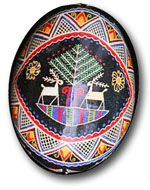Archives
Electronic Highways
The art of Ukrainian Easter egg decoration

Easter is Sunday, and one way to get into the spirit of the season is to decorate Easter eggs. There are a number of great Web sites that can get you started in creating and collecting beautiful Ukrainian Easter eggs, called pysanky.
Wikipedia provides a good overview of the history behind this ancient art (http://en.wikipedia.org/wiki
/Pysanka). The word comes from the Ukranian verb "pysaty," meaning "to write," as the designs are hand-written onto the egg in beeswax, rather then painted on. Before Christianity came to the Ukraine, the eggs were decorated with nature symbols and were used in spring rituals, representing Earth's rebirth. With the incorporation of Christianity into the culture, the eggs came to represent man's rebirth and the resurrection of Christ. The designs and colors placed on the eggs have symbolic meaning relating to the history behind this practice.
Each pysanka is intricately designed and colored for a spectacular end product. Thus, to create your own pysanky, some research is in order. Pysanka.com (http://www.pysanka.com/index.php) has a step-by-step guide for decorating the eggs. It involves writing the design on the egg, applying beeswax and continually dipping it into colored dye. The beeswax is applied over each color to act as a seal so that subsequent colors are added to the correct portions of the design. When the coloring process is completed, the wax is burned off the egg with a candle flame and the final, multicolored design emerges. You also might consider learnpysanky.com (http://www.learnpysanky.com/), which contains a tutorial on decorating the eggs and has links to pysanky workshops in the United States and Canada. This page has free beginner, intermediate and advanced designs, with instructions for each.
To purchase necessary supplies, particularly the dyes and the instrument used to apply the beeswax, you can visit allthingsukrainian.com (http://www.allthingsukrainian.com/Supplies/Supplies.htm) or the Ukrainian Gift Shop (http://www.ukrainiangiftshop.com/). Learnpysanky.com also has a list of suppliers (http://www.learnpysanky.com/suppliers/suppliers_us.html).
Although you can try your hand at creating your own pysanky for your personal admiration or as gifts, there are Web sites where you can buy professionally decorated eggs. Pysanky Collectibles is one such site (http://www.pysankycollectibles.com/). In addition to eggs, Pysanky Jewels (http://www.pysankyjewels.com/) offers jewelry and other collectibles decorated in pysanky style. Pysanka World (http://www.pysankaworld.com/) features designs on wooden eggs for purchase.
To see some striking examples of pysanky, you can visit the Pysanky Showcase (http://www.pysankyshowcase.com/), which features both traditional and contemporary designs created by well-known pysanky artists. Creatingpysanky.com (http://www.creatingpysanky.com/) also has an extensive egg gallery.
These eggs are exotic even in their most basic design, but one truly outrageous example is the world's largest pysanka in Vegreville, Alberta, Canada. It was created in 1974 to commemorate the 100th anniversary of the Royal Canadian Mounted Police. Pictures can be seen at http://www.geocities.com/wenjin92014/pysanka/VEGR.htm. A discussion of how this egg was created can be found at http://www.geocities.com/williamwchow/egg/e-egg.htm.
Happy spring!
—Tiffany Walsh, Arts and Sciences Libraries
